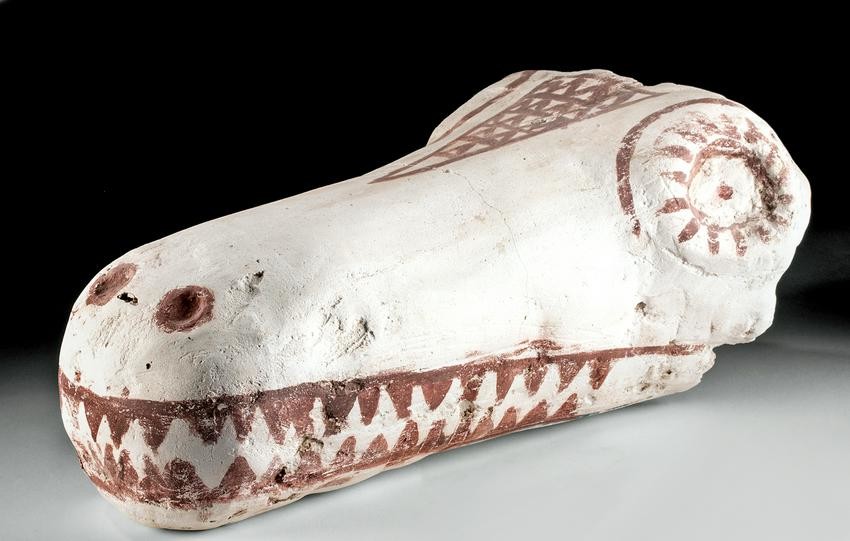Romano Egyptian Painted Plaster Crocodile Mummy Mask
Egypt, Romano-Egyptian period, ca. 1st to 2nd century CE. A wonderful hollow-molded plaster mummy mask for a crocodile, perhaps meant as an offering to Sobek, the crocodile-headed god of fertility and the Nile River. The mask bears characteristic reptilian features such as an elongated snout with a rounded muzzle, recessed nostrils, circular eyes within recessed sockets, and a smooth brow. Dark russet-red pigment illustrates several areas of the mask including the gnashing teeth, nostrils, eyes and lashes, and triangular marking centered on the forehead. Masks like this example were created when mummifying a certain type of animal - in this case a crocodile - and imprints of the original linen lining are still visible within the hollow interior. Size: 15.125" L x 9.75" W x 7.2" H (38.4 cm x 24.8 cm x 18.3 cm)
The crocodile was, and still is, one of the most awe-inspiring creatures in the animal kingdom. The ancient Egyptians both feared and revered crocodiles for their stealthy nature as well as their ferocious killing capabilities. According to scholar Dorothea Arnold, "Although the ancient Egyptians somewhat whimsically called the crocodile 'wrinkle face,' without a doubt these reptiles were the most dangerous creatures of their country and a constant threat to the people and their livestock" (Arnold, Dorothea. "An Egyptian Bestiary." The Metropolitan Museum of Art Bulletin, Spring 1995, Vol. LII, no. 4, p. 32). Concurrently in regards to the crocodile-headed god Sobek, Egyptologist Garry J. Shaw explains that, "As a god, [Sobek] was associated with the riverbanks and the marshland, and in some sources the Nile was said to be his sweat . . . [though] not content to dwell just in the river, Sobek was also called the Lord of Bakhu, a mythological mountain in the horizon, where he lived in a temple made from carnelian" (Shaw, Garry J. "The Egyptian Myths: A Guide to the Ancient Gods and Legends." Thames & Hudson, London, 2014, p. 137).
A stylistically similar example hammered for $12,500 at Christie's, New York "Antiquities" auction (sale 2323, June 10, 2010, lot 56).
Provenance: private J.H. collection, Beaverton, Oregon, USA, acquired around 2004; ex-Relics of the Nile, Washington, D.C., USA
All items legal to buy/sell under U.S. Statute covering cultural patrimony Code 2600, CHAPTER 14, and are guaranteed to be as described or your money back.
A Certificate of Authenticity will accompany all winning bids.
We ship worldwide to most countries and handle all shipping in-house for your convenience.
#150643
Condition Report: Repaired from multiple large pieces, with small chips and light adhesive residue along break lines. Nicks and abrasions to snout, face, underside, and peripheries, with minor fading to original pigmentation, and light encrustations within interior. Great earthen deposits and nice traces of original pigment throughout.
View it on
Estimate
Time, Location
Auction House
Egypt, Romano-Egyptian period, ca. 1st to 2nd century CE. A wonderful hollow-molded plaster mummy mask for a crocodile, perhaps meant as an offering to Sobek, the crocodile-headed god of fertility and the Nile River. The mask bears characteristic reptilian features such as an elongated snout with a rounded muzzle, recessed nostrils, circular eyes within recessed sockets, and a smooth brow. Dark russet-red pigment illustrates several areas of the mask including the gnashing teeth, nostrils, eyes and lashes, and triangular marking centered on the forehead. Masks like this example were created when mummifying a certain type of animal - in this case a crocodile - and imprints of the original linen lining are still visible within the hollow interior. Size: 15.125" L x 9.75" W x 7.2" H (38.4 cm x 24.8 cm x 18.3 cm)
The crocodile was, and still is, one of the most awe-inspiring creatures in the animal kingdom. The ancient Egyptians both feared and revered crocodiles for their stealthy nature as well as their ferocious killing capabilities. According to scholar Dorothea Arnold, "Although the ancient Egyptians somewhat whimsically called the crocodile 'wrinkle face,' without a doubt these reptiles were the most dangerous creatures of their country and a constant threat to the people and their livestock" (Arnold, Dorothea. "An Egyptian Bestiary." The Metropolitan Museum of Art Bulletin, Spring 1995, Vol. LII, no. 4, p. 32). Concurrently in regards to the crocodile-headed god Sobek, Egyptologist Garry J. Shaw explains that, "As a god, [Sobek] was associated with the riverbanks and the marshland, and in some sources the Nile was said to be his sweat . . . [though] not content to dwell just in the river, Sobek was also called the Lord of Bakhu, a mythological mountain in the horizon, where he lived in a temple made from carnelian" (Shaw, Garry J. "The Egyptian Myths: A Guide to the Ancient Gods and Legends." Thames & Hudson, London, 2014, p. 137).
A stylistically similar example hammered for $12,500 at Christie's, New York "Antiquities" auction (sale 2323, June 10, 2010, lot 56).
Provenance: private J.H. collection, Beaverton, Oregon, USA, acquired around 2004; ex-Relics of the Nile, Washington, D.C., USA
All items legal to buy/sell under U.S. Statute covering cultural patrimony Code 2600, CHAPTER 14, and are guaranteed to be as described or your money back.
A Certificate of Authenticity will accompany all winning bids.
We ship worldwide to most countries and handle all shipping in-house for your convenience.
#150643
Condition Report: Repaired from multiple large pieces, with small chips and light adhesive residue along break lines. Nicks and abrasions to snout, face, underside, and peripheries, with minor fading to original pigmentation, and light encrustations within interior. Great earthen deposits and nice traces of original pigment throughout.



